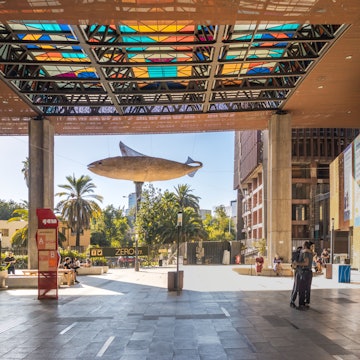
From seaside to mountain valley: the culinary riches of Chile

Oct 18, 2018 • 5 min read

Home to buzzing seafood markets, food-centric highland villages and sun-drenched vineyards, Chile offers a dazzling array of culinary temptations. The nation’s great size and wide-ranging geography has created astonishing variety when it comes to regional delicacies, and there are countless ways to partake of a memorable meal. You can indulge in ancient dishes fired up in earth ovens in Chiloé, linger over a solar-cooked feast in the Elqui Valley, and discover seafood delicacies on the hidden lanes of picturesque Valparaíso. It all goes down nicely with Chile’s famous wines and decadent pisco cocktails, too.

The Pacific Coast
No matter where you roam in Chile, you won’t be far from the ocean in this pencil-thin country with a coastline stretching over 4200km. The bountiful Pacific in its backyard gives Chile some of its best-loved staples including loco (abalone), erizos (sea urchins), machas (razor clams), jaibas (crabs), ostiones (scallops) and congrio (conger eel), plus yellowfin tuna, corvina, merluza (hake) and numerous other fish. Seafood lovers can hit vibrant mercados de mariscos (seafood markets) on or near the coast all the way from Arica in the north to Valdivia in the south. For a more targeted approach, plan a pilgrimage to Valparaíso. The bohemian port city is known for its colourful murals, steep cobblestone lanes, and a love for maritime cuisine. You can dine your way up and down the city hillsides, stopping for the fresh catch of the day at Restaurant La Concepcion, chalkboard specials at El Peral, and ceviche at Mm 450 La Cevicheria.

Elqui Valley
In the north of Chile, the Elqui Valley is a picturesque region of rolling hills, trickling mountain streams and clear night skies. It’s also the backdrop to hearty and satisfying Andean cuisine. In peaceful towns like Vicuña, you can tuck into filling plates of pastel del choclo (a casserole of sweet corn with hard-boiled eggs, olives and ground beef or chicken), or sample the local trout, perhaps finished with a traditional dessert like mote con huesillo (dried peaches with cinnamon, brown sugar and husked wheat). Chile is famed for its local goat cheeses, with hundreds of small producers nationwide, and the Valle del Elqui offers some outstanding varieties. Among the top labels in the valley is Tambo Alto, made by a sustainable producer (Agrícola El Calvario) that also grows table grapes.
The valley has nearly perfect weather, with over 320 days of sunshine put to good use in the creative restaurants of the village of Villaseca. There, several family-run eateries use solar ovens to bake bread, roast meats and fire up leche asada (flan) for dessert. One of the best is Delicias Del Sol.
You can’t leave the Elqui Valley before visiting at least one pisco distillery to get a closer look at the country’s national drink. The region is home to some of the nation’s top pisco producers, and you can learn all about its origins and its fabrication on a memorable tour and tasting at Pisquera Aba — one of many boutique operators in the valley.

Colchagua Valley
Less than 200km south of Santiago lies one of South America’s premier wine regions. The vineyards here have an incredible pedigree, with the first vines planted by Jesuit missionaries back in the mid-16th century. Fringed by mountains, the sun-drenched valley produces some of Chile’s best red wines, with great variety nourished by its diverse soils and microclimates. Among the best-known wines are bold reds with ripe tannins, made from grapes like Carménère, Cabernet Sauvignon, Syrah and Merlot. You can visit dozens of wineries in the region, touring sunny estates, followed by a tasting in the cellar. Sipping aside, there are plenty of other wine-centric activities to be had. At the award-winning Montgras, you can even make your own wine, creating a personal blend from three different varieties. The town of Santa Cruz is the gateway to the region — and also home to its lively Fiesta de la Vendimia (Grape Harvest Festival), held in early March each year.
When planning a wine-tasting trip, just be sure to have a designated driver, as Chile has a zero tolerance policy when it comes to drinking and driving. Better yet, take a tour. Those offered by Red del Vino take you to some of the valley’s most fascinating small-batch producers.

Chiloé Archipelago
Just north of Patagonia in Chile’s southern reaches, the mist-shrouded islands of Chiloé are home to a proud seafaring people with a strong independent streak. They have unique cultural traditions, one-of-a-kind architecture and perhaps most importantly (at least for foodies), their own rich cuisine. In photogenic food markets like those in the town of Ancud, you can sample satisfying cazuela (a meat and vegetable stew) or chupe (fish casserole), among many other dishes. The culinary highlight of any trip to the region, however, is curanto. This extraordinary dish, which likely predates the arrival of the Spanish, is traditionally prepared in earth ovens. Stones, heated in a bonfire until red hot, are set in a hole in the ground. Then the ingredients are directly piled on. First the shellfish, pork and chicken are added, followed by chapaleles (a kind of potato dumpling), various vegetables and the leaves of the nalca (a rhubarb-like plant). The whole mixture is covered and left to simmer for a couple of hours. Then the feasting begins! Many places around the archipelago serve curanto, though one of the best is fired up at Restaurant Quetalmahue, located in a small fishing village (also called Quetalmahue) around 15km west of Ancud.
Lonely Planet has produced this article for Chile Tourism. All editorial views are those of Lonely Planet alone and reflect our policy of editorial independence and impartiality.















